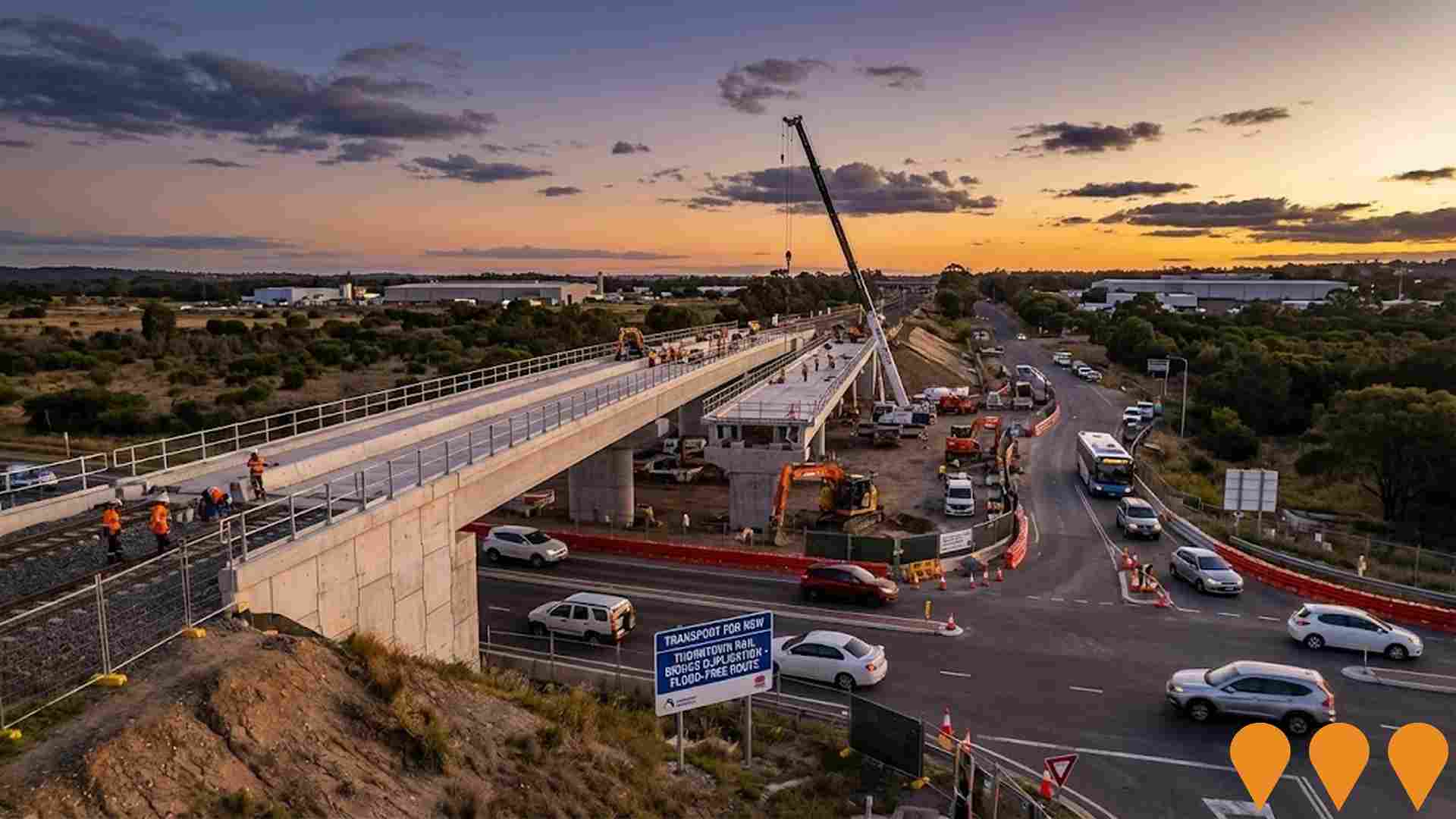Chart Color Schemes
est. as @ -- *
ABS ERP | -- people | --
2021 Census | -- people
Sales Activity
Curious about local property values? Filter the chart to assess the volume and appreciation (including resales) trends and regional comparisons, or scroll to the map below view this information at an individual property level.
Find a Recent Sale
Sales Detail
Population
An assessment of population growth drivers in East Maitland - Metford reveals an overall ranking slightly below national averages considering recent, and medium term trends
East Maitland - Metford's population was approximately 18,272 as of November 2025. This figure represents an increase of 291 people since the 2021 Census, which reported a population of 17,981. The increase is inferred from ABS estimates: 18,260 in June 2024 and 135 validated new addresses post-Census. This results in a density ratio of 842 persons per square kilometer. Population growth was primarily driven by natural growth contributing approximately 57.0% of overall population gains recently.
AreaSearch uses ABS/Geoscience Australia projections for each SA2 area, released in 2024 with 2022 as the base year. For uncovered areas, NSW State Government's SA2 level projections are used, released in 2022 with 2021 as the base year. Growth rates by age group are applied to all areas for years 2032 to 2041. Future trends project an above median population growth for regional Australia, with East Maitland - Metford expected to increase by 2,386 persons to 2041, reflecting a total increase of 13.0% over the 17 years.
Frequently Asked Questions - Population
Development
AreaSearch assessment of residential development drivers sees a low level of activity in East Maitland - Metford, placing the area among the bottom 25% of areas assessed nationally
East Maitland - Metford has seen approximately 30 dwelling approvals per year over the past five financial years, totalling 153 homes. In FY26, 10 approvals have been recorded so far. On average, 0.3 people moved to the area annually for each dwelling built between FY21 and FY25, indicating supply meeting or exceeding demand. The average construction cost of new homes is $340,000.
This financial year has seen $12.6 million in commercial approvals, suggesting steady investment activity. Compared to the rest of NSW, East Maitland - Metford has significantly lower building activity, 86.0% below the regional average per person. This constrained new construction typically reinforces demand and pricing for existing homes, which is also below the national average, implying an established area with potential planning limitations. New building activity comprises 54.0% standalone homes and 46.0% medium to high-density housing, offering choices across price ranges from spacious family homes to more affordable compact options. This shift reflects reduced development site availability and changing lifestyle demands and affordability requirements, differing from the current housing mix of 81.0% houses. The area's estimated population per dwelling approval is 581 people, indicating a quiet, low activity development environment.
Future projections suggest East Maitland - Metford will add 2,374 residents by 2041. If current construction levels persist, housing supply may lag behind population growth, potentially intensifying buyer competition and supporting price growth.
Frequently Asked Questions - Development
Infrastructure
East Maitland - Metford has strong levels of nearby infrastructure activity, ranking in the top 40% nationally
Changes to local infrastructure significantly influence an area's performance. AreaSearch has identified 17 projects likely impacting the area. Notable projects include Stony Pinch Urban Development, Bloomfield Colliery Continuation Project, Ashtonfield Public School Upgrade, and Sophia Waters Sportsground. The following list details those most relevant:.
Professional plan users can use the search below to filter and access additional projects.
INFRASTRUCTURE SEARCH
 Denotes AI-based impression for illustrative purposes only, not to be taken as definitive under any circumstances. Please follow links and conduct other investigations from the project's source for actual imagery. Developers and project owners wishing us to use original imagery please Contact Us and we will do so.
Denotes AI-based impression for illustrative purposes only, not to be taken as definitive under any circumstances. Please follow links and conduct other investigations from the project's source for actual imagery. Developers and project owners wishing us to use original imagery please Contact Us and we will do so.
Frequently Asked Questions - Infrastructure
Raymond Terrace and Heatherbrae Strategy 2020-2040
A long-term strategic plan to revitalise Raymond Terrace into a strong regional centre. The strategy includes the Raymond Terrace Public Domain Plan, mixed-use precincts, town centre streetscape upgrades, and the delivery of approximately 2,500 new homes by 2041 to support population growth.
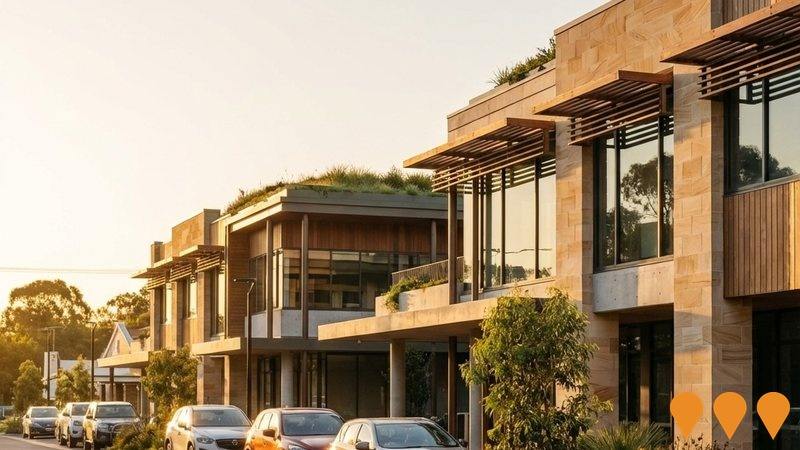
Maitland Local Housing Strategy 2041
A comprehensive strategic planning framework adopted by Maitland City Council on 27 June 2023 and endorsed by the NSW Government on 9 September 2024. The strategy guides residential development and growth in the Maitland local government area through to 2041. It identifies areas for new housing, prioritizes infill development and housing diversity (including affordable housing) to meet the projected need for approximately 25,200 additional dwellings by 2041, and aligns infrastructure planning to support growth.
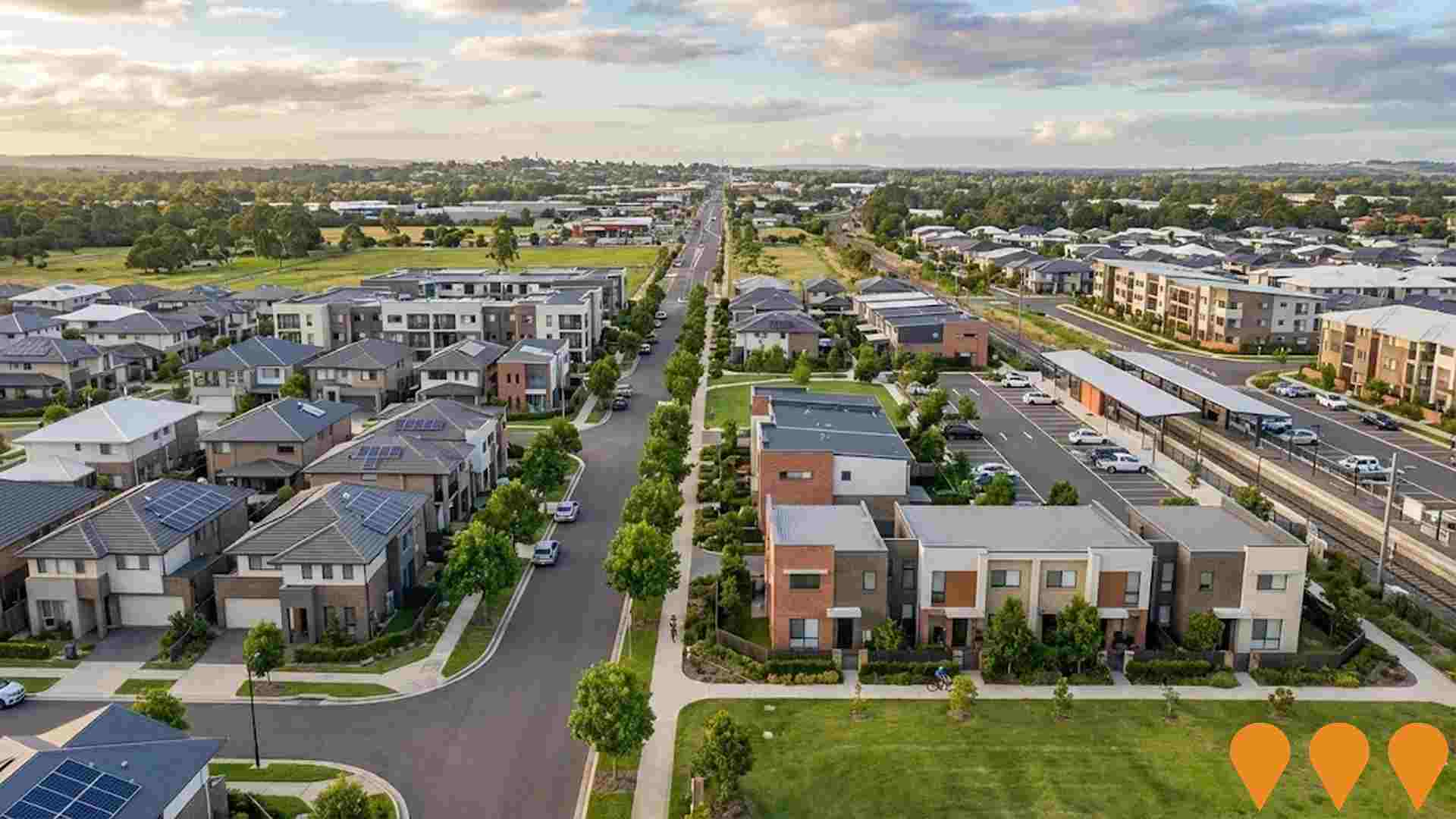
East Maitland Catalyst Area
The East Maitland Catalyst Area (EMCA) is a NSW Government-priority precinct for housing acceleration and health services growth. It is planned to deliver up to 4,815 new dwellings over the next 20 years, supported by the new Maitland Hospital (completed 2022), Maitland Private Hospital expansion, and Stockland Green Hills regional shopping centre. A Place Strategy and structure planning are currently underway, funded by the NSW Government's Housing Accelerator Fund and Priority Precincts program.
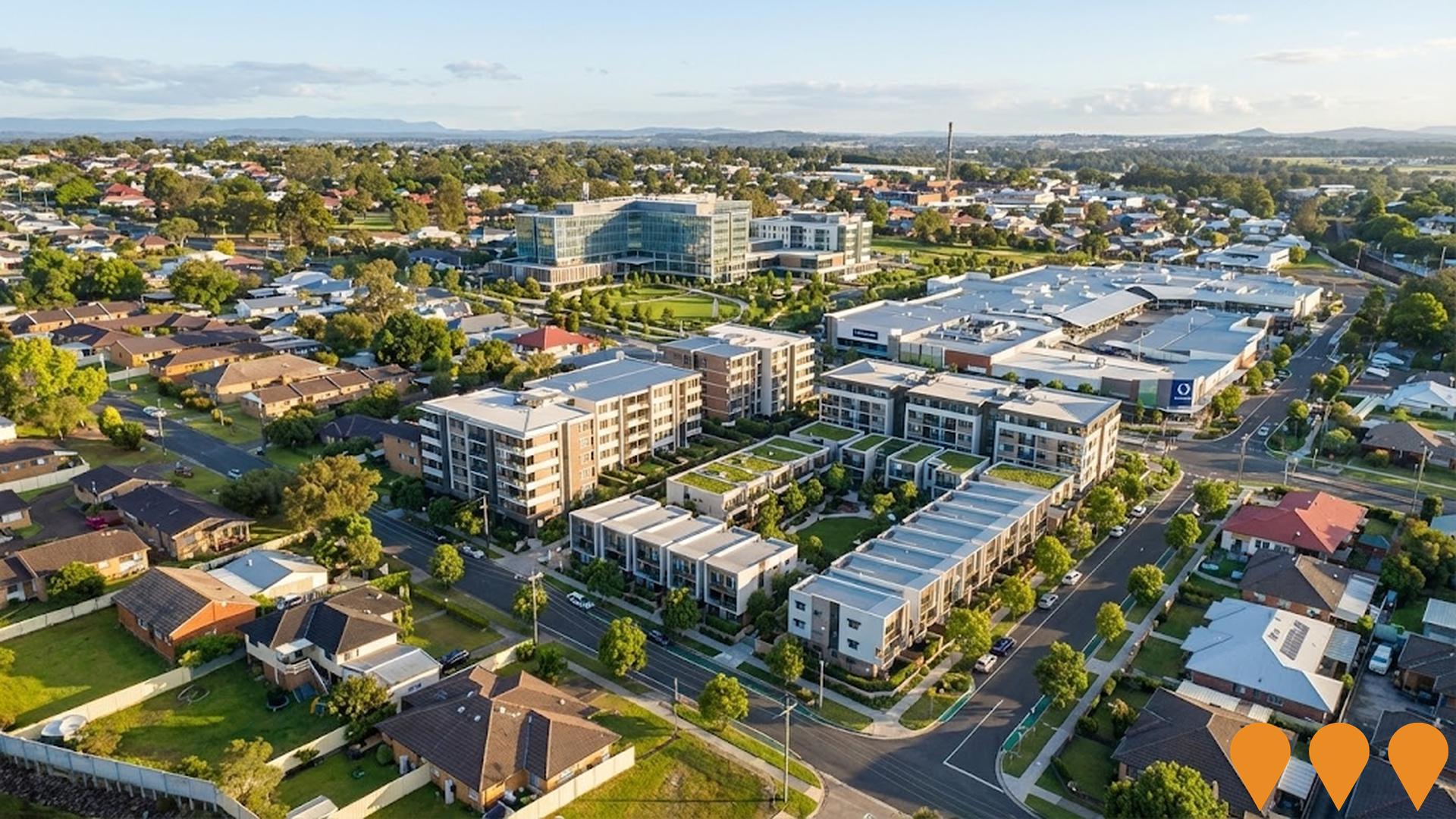
Stony Pinch Urban Development
Long-term conceptual urban development proposal for the post-mining rehabilitation of the Bloomfield Colliery site in Ashtonfield, lower Hunter Valley. The site spans approximately 3,600 hectares and is envisioned to accommodate up to 19,200 dwellings along with employment lands, town centre, recreation facilities and preserved bushland. The Bloomfield Colliery is currently operational with mining approval until 2035. Specific development timelines and details for the urban transformation remain subject to mine rehabilitation completion and future planning approvals under the Stony Pinch consortium and Ashtonfields Agreement.
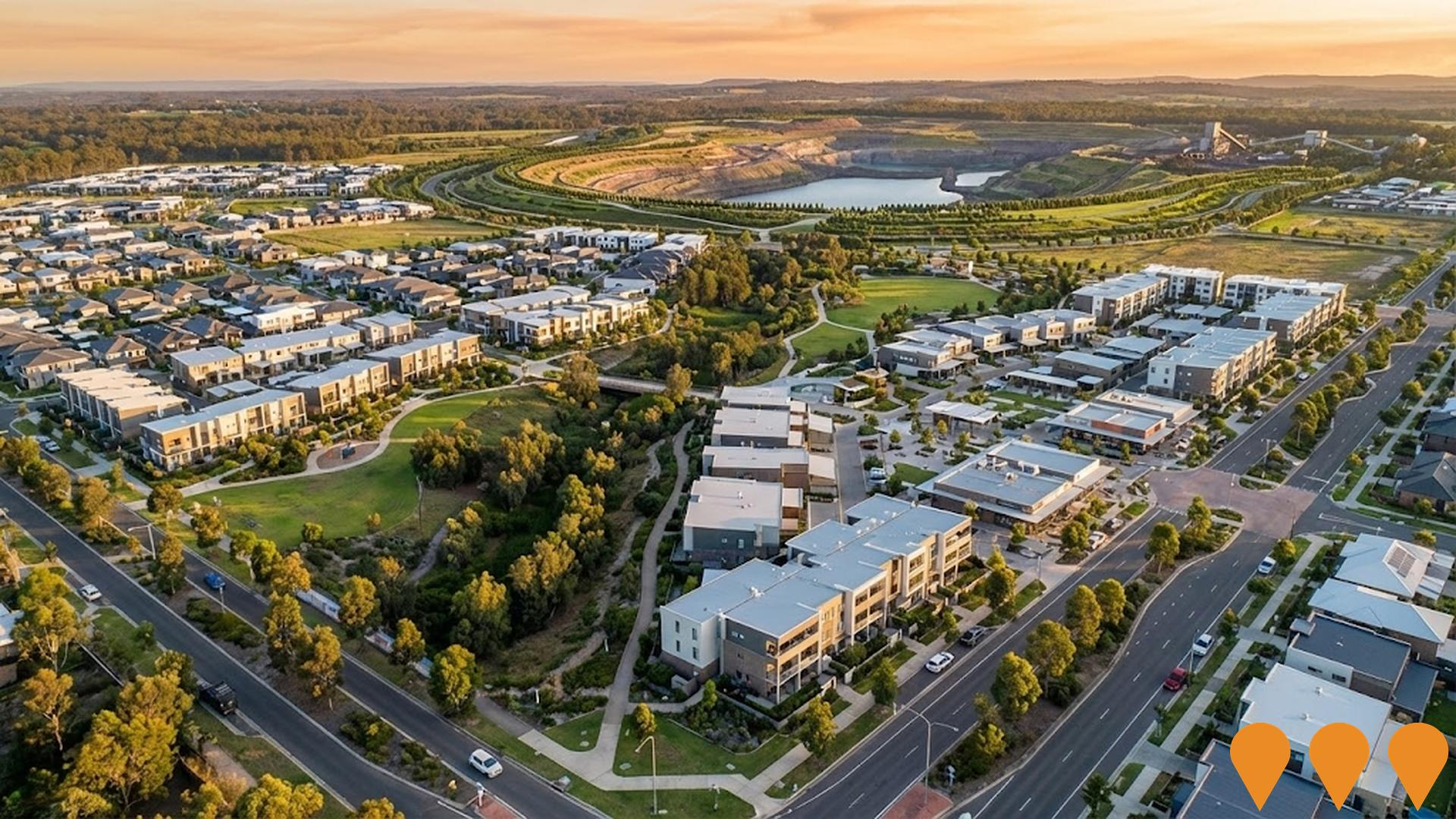
New Maitland Hospital
A $470 million state-of-the-art 339-bed hospital featuring emergency care, maternity services, paediatric care, surgical services, chemotherapy chairs, and a rooftop helipad. The seven-storey, 50,000 square metre facility provides 150 additional beds and treatment spaces compared to the previous hospital, serving the growing health needs of the Maitland and Hunter Valley communities. Built on a decommissioned brick quarry site with contemporary design, the hospital includes critical care, mental health services, cardiac catheterisation, palliative care, outpatient clinics and dental services.
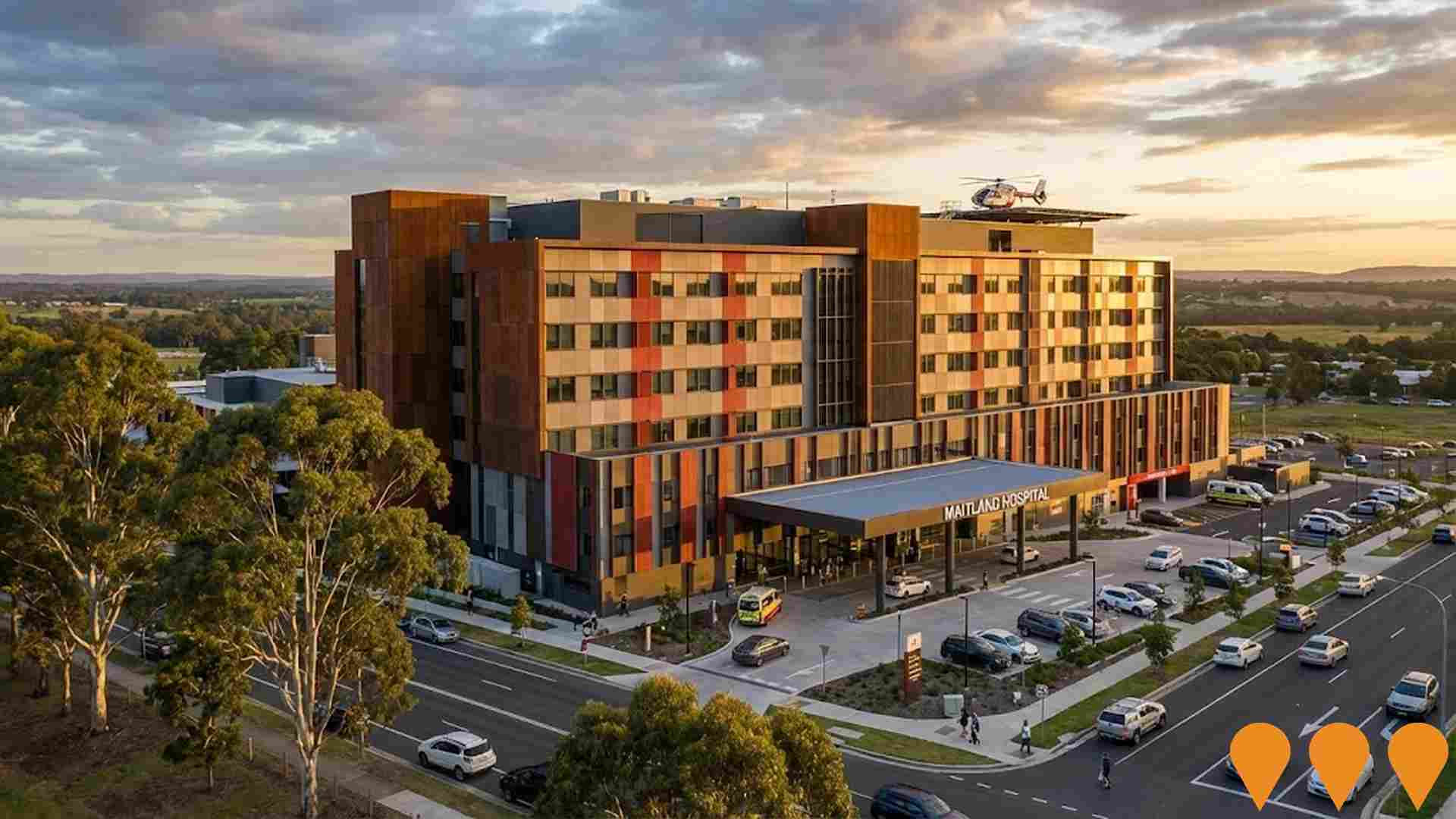
Sophia Waters Estate
Sophia Waters Estate is a major master-planned residential development in Chisholm near Maitland, featuring over 1500 planned dwellings across multiple stages. The estate emphasizes open spaces, extensive landscaping, and community amenities including a new $10 million Maitland Council sportsground scheduled for completion in late 2026. Located in the picturesque Hunter Valley with easy access to Newcastle, Lake Macquarie, and Port Stephens.

Stockland Green Hills Expansion
A $414 million expansion that doubled the size of the shopping centre to 74,000 square metres, adding a second level with over 220 specialty stores including David Jones, H&M, Target, JB Hi-Fi, and The Courtyard outdoor dining precinct with LED light trees. The development features 3,125 car parking spaces and represents the largest retail redevelopment completed in Australia in 2018.

Sophia Waters Sportsground
New neighbourhood sportsground in Sophia Waters, Chisholm. Scope includes two mixed sports fields, turf cricket wicket, amenities building with accessible facilities, canteen and storage, irrigation and field lighting, fencing, over 100 parking spaces, and an adjacent playspace. Council started works in May 2025 with completion targeted for late 2026.
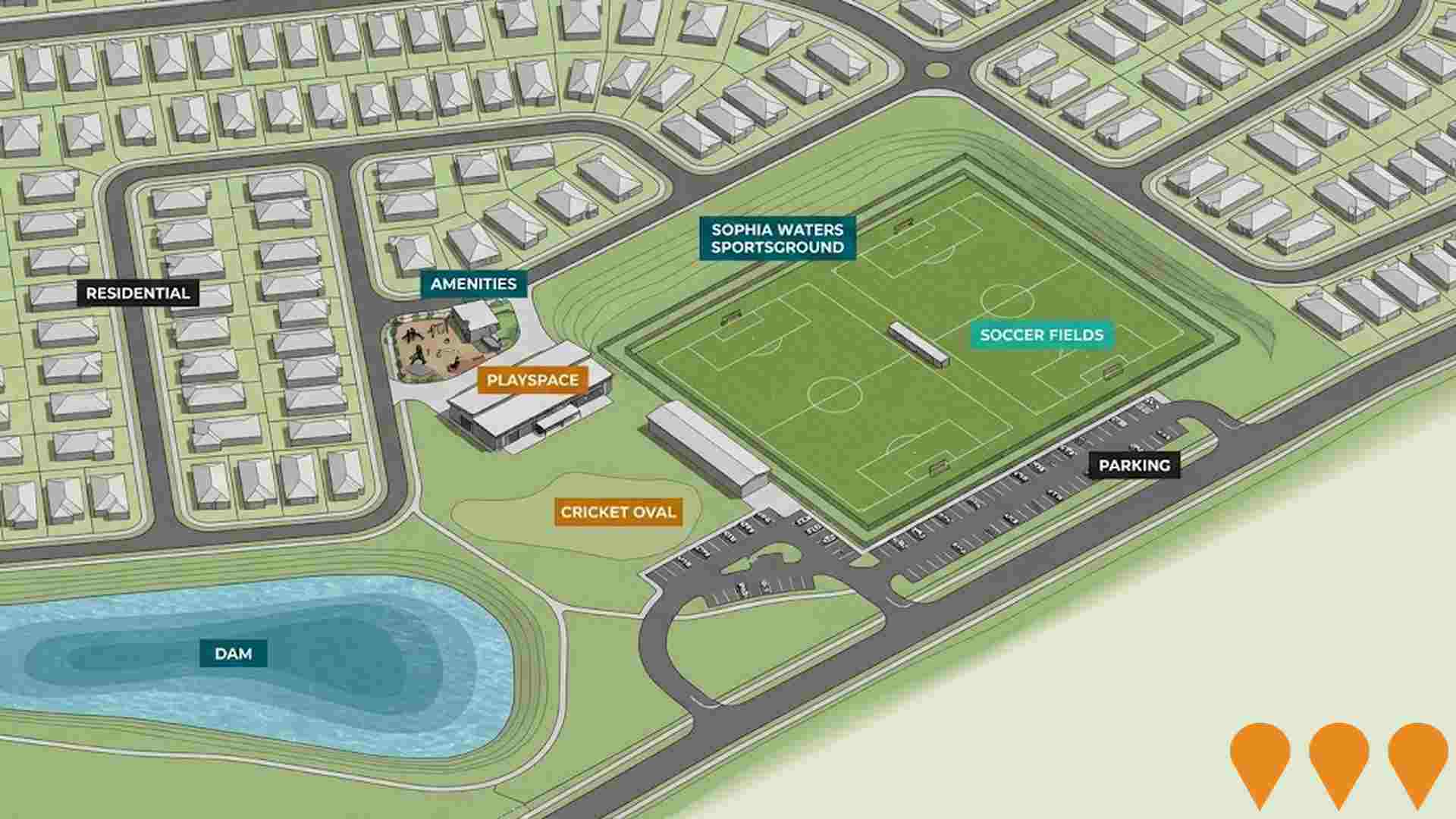
Employment
Despite maintaining a low unemployment rate of 3.7%, East Maitland - Metford has experienced recent job losses, resulting in a below average employment performance ranking when compared nationally
East Maitland - Metford has a skilled workforce with 8931 residents employed as of June 2025. The unemployment rate is 3.7%, matching the Rest of NSW's rate.
Workforce participation is higher at 61.6%. Key employment sectors include health care & social assistance, retail trade, and construction. Mining shows strong specialization with an employment share twice the regional level, while agriculture, forestry & fishing has lower representation at 1%. Many residents commute elsewhere for work based on Census data.
In the year ending June 2025, labour force decreased by 4.2% and employment declined by 4.6%, leading to an unemployment rate rise of 0.4 percentage points. This contrasts with Rest of NSW where employment contracted by 0.1%. National employment forecasts from Jobs and Skills Australia (May 2025) project a 6.6% growth over five years and 13.7% over ten years. Applying these projections to East Maitland - Metford's employment mix suggests local growth of approximately 6.3% over five years and 13.4% over ten years, based on simple weighting extrapolation for illustrative purposes.
Frequently Asked Questions - Employment
Income
Income levels align closely with national averages, indicating typical economic conditions for Australian communities according to AreaSearch analysis
According to AreaSearch's aggregation of latest postcode level ATO data released for financial year ended June 2022, East Maitland - Metford had a median income among taxpayers of $52,533 with the average level standing at $64,560. These figures are in line with national averages and compare to levels of $49,459 and $62,998 across Rest of NSW respectively. Based on Wage Price Index growth of 12.61% since financial year ended June 2022, current estimates would be approximately $59,157 (median) and $72,701 (average) as of September 2025. According to Australian Census figures for 2021, household, family and personal incomes in East Maitland - Metford rank modestly, between the 41st and 41st percentiles. Income analysis reveals that the largest segment comprises 33.1% earning $1,500 - $2,999 weekly (6,048 residents), reflecting patterns seen in the broader area where 29.9% similarly occupy this range. Housing affordability pressures are severe, with only 83.5% of income remaining after housing costs, ranking at the 41st percentile. The area's SEIFA income ranking places it in the 4th decile.
Frequently Asked Questions - Income
Housing
East Maitland - Metford is characterized by a predominantly suburban housing profile, with above-average rates of outright home ownership
Dwelling structure in East Maitland - Metford, as per the latest Census, consisted of 81.1% houses and 18.9% other dwellings (semi-detached, apartments, 'other' dwellings). This compares to Non-Metro NSW's 87.1% houses and 13.0% other dwellings. Home ownership in East Maitland - Metford was at 30.0%, similar to Non-Metro NSW. The remaining dwellings were either mortgaged (35.2%) or rented (34.8%). The median monthly mortgage repayment in the area was $1,733, lower than Non-Metro NSW's average of $1,862. Median weekly rent was recorded at $350, compared to Non-Metro NSW's $375. Nationally, East Maitland - Metford's mortgage repayments were lower than the Australian average of $1,863, and rents were less than the national figure of $375.
Frequently Asked Questions - Housing
Household Composition
East Maitland - Metford has a typical household mix, with a lower-than-average median household size
Family households constitute 70.4% of all households, including 30.0% couples with children, 25.7% couples without children, and 13.5% single parent families. Non-family households account for the remaining 29.6%, with lone person households at 26.8% and group households comprising 2.8%. The median household size is 2.5 people, which is smaller than the Rest of NSW average of 2.7.
Frequently Asked Questions - Households
Local Schools & Education
East Maitland - Metford shows below-average educational performance compared to national benchmarks, though pockets of achievement exist
The area's university qualification rate is 18.0%, significantly lower than the NSW average of 32.2%. This presents both a challenge and an opportunity for targeted educational initiatives. Bachelor degrees are most prevalent at 12.8%, followed by postgraduate qualifications (3.4%) and graduate diplomas (1.8%). Trade and technical skills are prominent, with 41.0% of residents aged 15+ holding vocational credentials - advanced diplomas (10.8%) and certificates (30.2%).
Educational participation is high, with 29.7% of residents currently enrolled in formal education. This includes 10.4% in primary education, 8.3% in secondary education, and 4.2% pursuing tertiary education. A network of 9 schools operates within East Maitland - Metford, educating approximately 3,857 students. The area demonstrates typical Australian school conditions (ICSEA: 1000) with balanced educational opportunities. The educational mix includes 4 primary and 5 K-12 schools.
Frequently Asked Questions - Education
Schools Detail
Nearby Services & Amenities
Transport
Transport servicing is high compared to other areas nationally based on assessment of service frequency, route connectivity and accessibility
East Maitland - Metford has 180 active public transport stops. These serve a mix of train and bus routes totalling 150 individual services. The area's residents have excellent accessibility to these stops, with an average distance of 150 meters to the nearest one.
Weekly passenger trips total 6,185. Service frequency averages 883 trips per day across all routes, equating to approximately 34 weekly trips per stop.
Frequently Asked Questions - Transport
Transport Stops Detail
Health
Health performance in East Maitland - Metford is well below average with prevalence of common health conditions notable across both younger and older age cohorts
East Maitland - Metford faces significant health challenges, as indicated by its health data.
The prevalence of common health conditions is notable across both younger and older age groups. Private health cover stands at approximately 52% of the total population (~9,483 people), which is slightly higher than the average SA2 area. Mental health issues and arthritis are the most prevalent medical conditions in the area, affecting 12.2% and 9.7% of residents respectively. However, 61.4% of residents declare themselves completely clear of medical ailments, compared to 63.4% across Rest of NSW. The area has a higher proportion of seniors aged 65 and over at 17.5%, with 3,195 people falling into this age group, compared to 15.4% in Rest of NSW. Health outcomes among seniors present some challenges, broadly aligning with the general population's health profile.
Frequently Asked Questions - Health
Cultural Diversity
East Maitland - Metford is considerably less culturally diverse than average when assessed alongside AreaSearch's national rankings for language and cultural background related metrics
East Maitland-Metford showed low cultural diversity, with 89.0% born in Australia, 91.7% being citizens, and 92.9% speaking English only at home. Christianity was the dominant religion at 56.8%, slightly lower than the regional average of 57.0%. The top three ancestry groups were English (31.5%), Australian (30.9%), and Irish (8.2%).
Notably, Australian Aboriginal people were overrepresented at 4.8% compared to the regional average of 5.1%. Welsh and Samoan populations were also notably present at 0.6% and 0.2%, respectively.
Frequently Asked Questions - Diversity
Age
East Maitland - Metford's population is slightly older than the national pattern
The median age in East Maitland - Metford is 39 years, which is significantly below Rest of NSW's average of 43 but essentially aligned with Australia's median age of 38 years. Compared to Rest of NSW, East Maitland - Metford has a higher concentration of residents aged 25-34 (14.1%) but fewer residents aged 65-74 (9.7%). According to the 2021 Census, the age group 25 to 34 has grown from 12.6% to 14.1% of the population, while the age group 5 to 14 has declined from 13.6% to 12.4%. By 2041, demographic projections indicate significant shifts in East Maitland - Metford's age structure, with the 25 to 34 age group expected to grow by 30%, reaching 3,352 people from 2,569. Conversely, the 55 to 64 and 15 to 24 age groups are projected to experience population declines.


